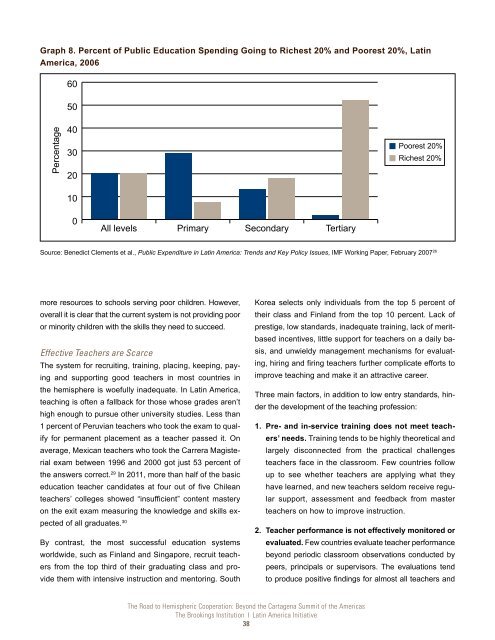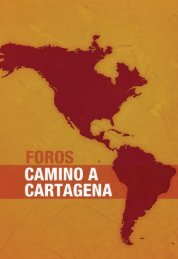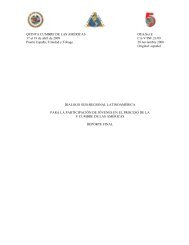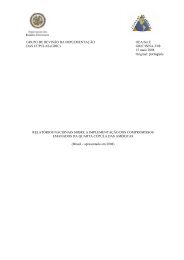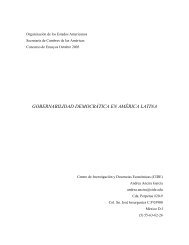The Road to Hemispheric Cooperation: Beyond the Cartagena
The Road to Hemispheric Cooperation: Beyond the Cartagena
The Road to Hemispheric Cooperation: Beyond the Cartagena
Create successful ePaper yourself
Turn your PDF publications into a flip-book with our unique Google optimized e-Paper software.
Graph 8. Percent of Public Education Spending Going <strong>to</strong> Richest 20% and Poorest 20%, Latin<br />
America, 2006<br />
Percentage<br />
60<br />
50<br />
40<br />
30<br />
20<br />
10<br />
0<br />
All levels<br />
Primary<br />
more resources <strong>to</strong> schools serving poor children. However,<br />
overall it is clear that <strong>the</strong> current system is not providing poor<br />
or minority children with <strong>the</strong> skills <strong>the</strong>y need <strong>to</strong> succeed.<br />
Effective Teachers are Scarce<br />
<strong>The</strong> system for recruiting, training, placing, keeping, paying<br />
and supporting good teachers in most countries in<br />
<strong>the</strong> hemisphere is woefully inadequate. In Latin America,<br />
teaching is often a fallback for those whose grades aren’t<br />
high enough <strong>to</strong> pursue o<strong>the</strong>r university studies. Less than<br />
1 percent of Peruvian teachers who <strong>to</strong>ok <strong>the</strong> exam <strong>to</strong> qualify<br />
for permanent placement as a teacher passed it. On<br />
average, Mexican teachers who <strong>to</strong>ok <strong>the</strong> Carrera Magisterial<br />
exam between 1996 and 2000 got just 53 percent of<br />
<strong>the</strong> answers correct. 29 In 2011, more than half of <strong>the</strong> basic<br />
education teacher candidates at four out of five Chilean<br />
teachers’ colleges showed “insufficient” content mastery<br />
on <strong>the</strong> exit exam measuring <strong>the</strong> knowledge and skills expected<br />
of all graduates. 30<br />
By contrast, <strong>the</strong> most successful education systems<br />
worldwide, such as Finland and Singapore, recruit teachers<br />
from <strong>the</strong> <strong>to</strong>p third of <strong>the</strong>ir graduating class and provide<br />
<strong>the</strong>m with intensive instruction and men<strong>to</strong>ring. South<br />
Secondary<br />
Tertiary<br />
Korea selects only individuals from <strong>the</strong> <strong>to</strong>p 5 percent of<br />
<strong>the</strong>ir class and Finland from <strong>the</strong> <strong>to</strong>p 10 percent. Lack of<br />
prestige, low standards, inadequate training, lack of meritbased<br />
incentives, little support for teachers on a daily basis,<br />
and unwieldy management mechanisms for evaluating,<br />
hiring and firing teachers fur<strong>the</strong>r complicate efforts <strong>to</strong><br />
improve teaching and make it an attractive career.<br />
Three main fac<strong>to</strong>rs, in addition <strong>to</strong> low entry standards, hinder<br />
<strong>the</strong> development of <strong>the</strong> teaching profession:<br />
1. Pre- and in-service training does not meet teachers’<br />
needs. Training tends <strong>to</strong> be highly <strong>the</strong>oretical and<br />
largely disconnected from <strong>the</strong> practical challenges<br />
teachers face in <strong>the</strong> classroom. Few countries follow<br />
up <strong>to</strong> see whe<strong>the</strong>r teachers are applying what <strong>the</strong>y<br />
have learned, and new teachers seldom receive regular<br />
support, assessment and feedback from master<br />
teachers on how <strong>to</strong> improve instruction.<br />
2. Teacher performance is not effectively moni<strong>to</strong>red or<br />
evaluated. Few countries evaluate teacher performance<br />
beyond periodic classroom observations conducted by<br />
peers, principals or supervisors. <strong>The</strong> evaluations tend<br />
<strong>to</strong> produce positive findings for almost all teachers and<br />
<strong>The</strong> <strong>Road</strong> <strong>to</strong> <strong>Hemispheric</strong> <strong>Cooperation</strong>: <strong>Beyond</strong> <strong>the</strong> <strong>Cartagena</strong> Summit of <strong>the</strong> Americas<br />
<strong>The</strong> Brookings Institution ❘ Latin America Initiative<br />
38<br />
Poorest 20%<br />
Richest 20%<br />
Source: Benedict Clements et al., Public Expenditure in Latin America: Trends and Key Policy Issues, IMF Working Paper, February 2007 26


